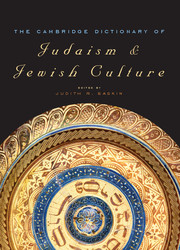Book contents
T
Published online by Cambridge University Press: 05 August 2014
Summary
Tabernacle (mishkan in Hebrew, literally “dwelling”) refers to the portable shrine described in the *Pentateuch as accompanying the Israelites throughout their wilderness wanderings. The Tabernacle served as the center of sacrificial and cultic activity and was also the place where the *Ark of the Covenant was housed. According to Exodus 40:34, “the cloud covered the Tent of Meeting, and the Presence of the Lord filled the Tabernacle.” Directions as to the construction of the Tabernacle and its component parts were revealed to Moses at Mount Sinai (Exod 25–27). It was to be erected facing eastward wherever the Israelites camped, and the tribes were to be arrayed around it in a prescribed pattern. Modern scholarship assigns the detailed traditions about building of the Tabernacle and the types of sacrifices to be offered there (Leviticus) to the Priestly strand of biblical authorship (see BIBLE: MODERN SCHOLARSHIP). According to these texts, the priests or kohanim, the descendants of *Aaron, brother of *Moses, officiated at the Tabernacle, while other members of the tribe of Levi, the “regular” Levites, had subservient roles (see PRIESTHOOD).
Many modern scholars question the historicity of the Tabernacle narratives described in the *Torah and suggest that Priestly writers of a later era projected their vision of a wilderness mishkan to reinforce the significance of the Jerusalem *Temple, “the place in which I will put my name” (Deut 12:5), to worshipers of their own time. Others suggest that stories about the Tabernacle reflect a shrine from the reign of King *David, which itself would have been based on shrines from the pre-monarchic period of Israelite life in the Land of Israel.
- Type
- Chapter
- Information
- The Cambridge Dictionary of Judaism and Jewish Culture , pp. 582 - 618Publisher: Cambridge University PressPrint publication year: 2011



